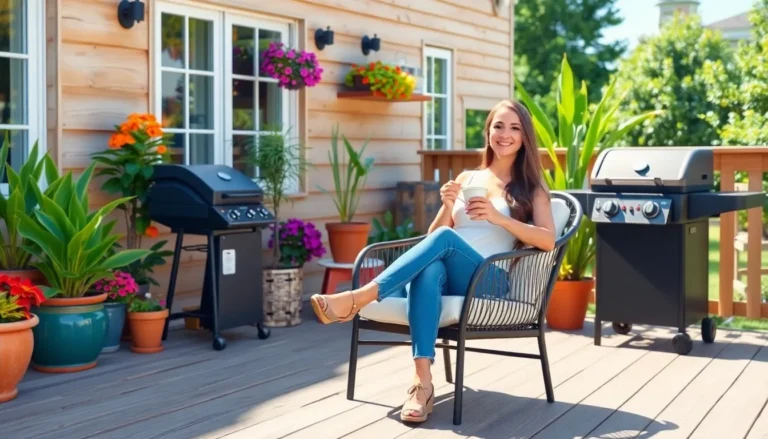Imagine stepping onto your deck, only to find it’s a slip-and-slide waiting to happen. Waterlogged wood and soggy surfaces can turn your outdoor oasis into a soggy mess. But fear not! Waterproof outdoor flooring is here to save the day—and your dignity.
Table of Contents
ToggleOverview of Waterproof Outdoor Flooring for Decks
Waterproof outdoor flooring for decks offers a practical solution for homeowners facing challenges from water damage. This type of flooring prevents moisture from penetrating the surface, reducing the risk of mold, mildew, and structural damage. It remains particularly beneficial in regions with higher rainfall or humidity levels.
Various materials, such as vinyl, composite, and rubber, provide durability and weather resistance. Vinyl planks or tiles feature a waterproof core, enhancing longevity while mimicking natural wood or stone. Composite flooring combines wood fibers and plastic, creating a slip-resistant surface that’s easy to maintain.
Installation processes vary based on selected materials. Interlocking panels or planks simplify assembly, while some options might require professional assistance.
Furthermore, waterproof outdoor flooring comes in a range of designs and colors. Homeowners can create an aesthetic that aligns with their outdoor decor, enhancing the overall appearance of their living space.
Budget considerations are crucial when selecting the right flooring. Prices typically range from $2 to $10 per square foot, depending on material quality and installation methods. Although the initial investment may be higher, the long-term benefits of protection against water damage and reduced maintenance costs justify the expense.
Selecting the right waterproof flooring can significantly impact the functionality and safety of an outdoor deck. This choice guarantees a reliable, attractive surface that withstands the elements while providing comfort and style.
Types of Waterproof Outdoor Flooring
Waterproof outdoor flooring options enhance deck safety and appearance. These materials cater to various preferences and budgets.
Vinyl Decking
Vinyl decking offers a versatile choice for outdoor flooring. It mimics the look of natural wood or stone while providing excellent moisture resistance. Manufacturers design vinyl planks to be lightweight yet durable. Many homeowners appreciate its ease of maintenance and cleaning. Prices typically range from $3 to $8 per square foot. This option is suitable for DIY projects, as installation often involves interlocking panels.
Composite Decking
Composite decking combines wood fibers and plastic for a robust flooring option. This material resists fading, staining, and moisture, making it a popular choice for decks. Its slip-resistant surface enhances safety during wet conditions. Homeowners find that composite decking requires minimal maintenance, saving time and effort. Prices average between $5 and $10 per square foot. Many manufacturers offer a variety of colors and textures, allowing customization to suit individual styles.
Tile and Pavers
Tile and pavers provide an elegant look for outdoor spaces. Many designs feature slip-resistant surfaces for added safety. These materials withstand harsh weather conditions while remaining visually appealing. Installation often requires professional help, especially for intricate patterns. Prices for tile and pavers typically range from $4 to $12 per square foot, depending on the material chosen. Various styles and colors ensure homeowners can find the perfect fit for their deck aesthetic.
Benefits of Waterproof Outdoor Flooring
Waterproof outdoor flooring offers several advantages, enhancing both functionality and aesthetics of decks. These benefits include durability, low maintenance, and aesthetic appeal.
Durability
Durability stands out as a primary advantage of waterproof outdoor flooring. Materials such as vinyl and composite feature resistance to moisture, fading, and warping. Longevity is another key point; homeowners experience fewer replacements due to wear and damage. Outdoor environments, subject to harsh weather, require flooring that withstands rain, snow, and UV exposure. Flooding or water pooling becomes less of a concern, making spaces safer and more usable. Investing in waterproof options ensures not only immediate performance but also reliable longevity.
Maintenance
Low maintenance requirements characterize waterproof outdoor flooring. Cleaning typically involves simple sweeping or occasional mopping, making upkeep hassle-free. Mold and mildew growth decreases significantly, reducing the need for heavy-duty cleaning products. Time and effort saved on maintenance translate into more enjoyable outdoor experiences. Additionally, options like vinyl and composite resist stains, helping maintain a clean, attractive appearance. Regular inspections enhance longevity, ensuring lasting beauty with minimal effort.
Aesthetic Appeal
Aesthetic appeal enhances the attraction of waterproof outdoor flooring. Available in various designs and colors, homeowners can choose styles that suit their preferences. Flooring materials effectively mimic the look of natural wood or stone, maintaining elegance while providing functionality. Complementing outdoor decor or landscaping becomes effortless with these options. The combination of beauty and practicality makes these materials a preferred choice for many homeowners. Unique styles encourage creativity in outdoor spaces, encouraging individuals to express their tastes while benefiting from the practicality of waterproof flooring.
Popular Brands and Products
Several brands stand out in the waterproof outdoor flooring market. Trex, known for its composite decking, offers a range of colors and textures that resist fading and ensure long-lasting performance. Products from Trex typically range in price from $5 to $10 per square foot, providing a balance of durability and style.
Fiberon is another reputable brand, specializing in composite and PVC decking options. Fiberon’s products feature a slip-resistant surface, making them ideal for outdoor use. Pricing for Fiberon flooring aligns closely with Trex, generally falling between $5 to $10 per square foot, with a variety of design choices available.
DuraGrid excels in the rubber flooring category, providing interlocking tiles that drain water effectively. This brand offers customization with vibrant colors and patterns, encouraging creativity in outdoor spaces. DuraGrid tiles often retail around $4 to $8 per square foot.
WeatherDek provides high-quality vinyl decking solutions designed specifically for outdoor environments. Multiple styles mimic natural materials, enhancing visual appeal on decks. WeatherDek’s products average between $3 to $8 per square foot, appealing for those seeking both aesthetics and function.
Finally, Nantucket Pavers presents an elegant approach with tile flooring options. Their products withstand various weather conditions while offering a sophisticated look. Prices range from $4 to $12 per square foot, justifying the investment for homeowners wanting a luxurious finish.
Evaluating these brands and products ensures the selection of suitable waterproof flooring that combines functionality with aesthetic charm.
Installation and Cost Considerations
Installation methods for waterproof outdoor flooring vary significantly based on material type. Vinyl planks often feature interlocking designs that simplify the installation process, allowing for an easier DIY approach. Composite decking, while durable, typically requires more precise installation, sometimes necessitating the help of a professional to ensure a high-quality finish.
Tile and paver installation can involve intricate layouts, making professional assistance advisable for optimal results. Budgeting for installation should account for both material costs and labor expenses. Pricing for waterproof flooring commonly ranges from $2 to $10 per square foot, based on material choice and installation complexity.
For example, vinyl decking generally costs between $3 to $8 per square foot, offering an economical yet stylish option. Composite decking’s average price sits between $5 to $10 per square foot, reflecting its durability and slip-resistant features. Elegant tile options, while aesthetically pleasing, may range from $4 to $12 per square foot, considering the benefits of performance in outdoor environments.
Long-term cost advantages emerge from investing in quality waterproof flooring. Protection against water damage translates to lower repair and replacement costs over time. Reduced maintenance needs also contribute to overall affordability, with minimal cleaning required compared to traditional materials.
Evaluating multiple brands can provide insights into pricing and product selection. For instance, Trex and Fiberon offer composite options at similar price points. DuraGrid’s rubber tiles present an affordable alternative, while WeatherDek and Nantucket Pavers focus on high-end vinyl and tile solutions. An informed decision on waterproof outdoor flooring balances upfront costs with expected longevity and aesthetic impact.
Choosing waterproof outdoor flooring for decks is a smart investment that enhances safety and aesthetics. With options like vinyl, composite, and tile, homeowners can find materials that suit their style and budget. These durable surfaces resist moisture and require minimal maintenance, ensuring long-lasting beauty and functionality.
By evaluating different brands and materials, it’s possible to select the perfect flooring that meets specific needs. Investing in quality waterproof flooring not only protects against water damage but also elevates outdoor living spaces, making them enjoyable year-round. With the right choice, outdoor decks can remain safe, stylish, and functional for years to come.






